Petrogenesis and Geodynamic Implications of the North Kudi Granitoids in the West Kunlun Orogen, NW China
Abstract
1. Introduction
2. Geological Setting and Sample Descriptions
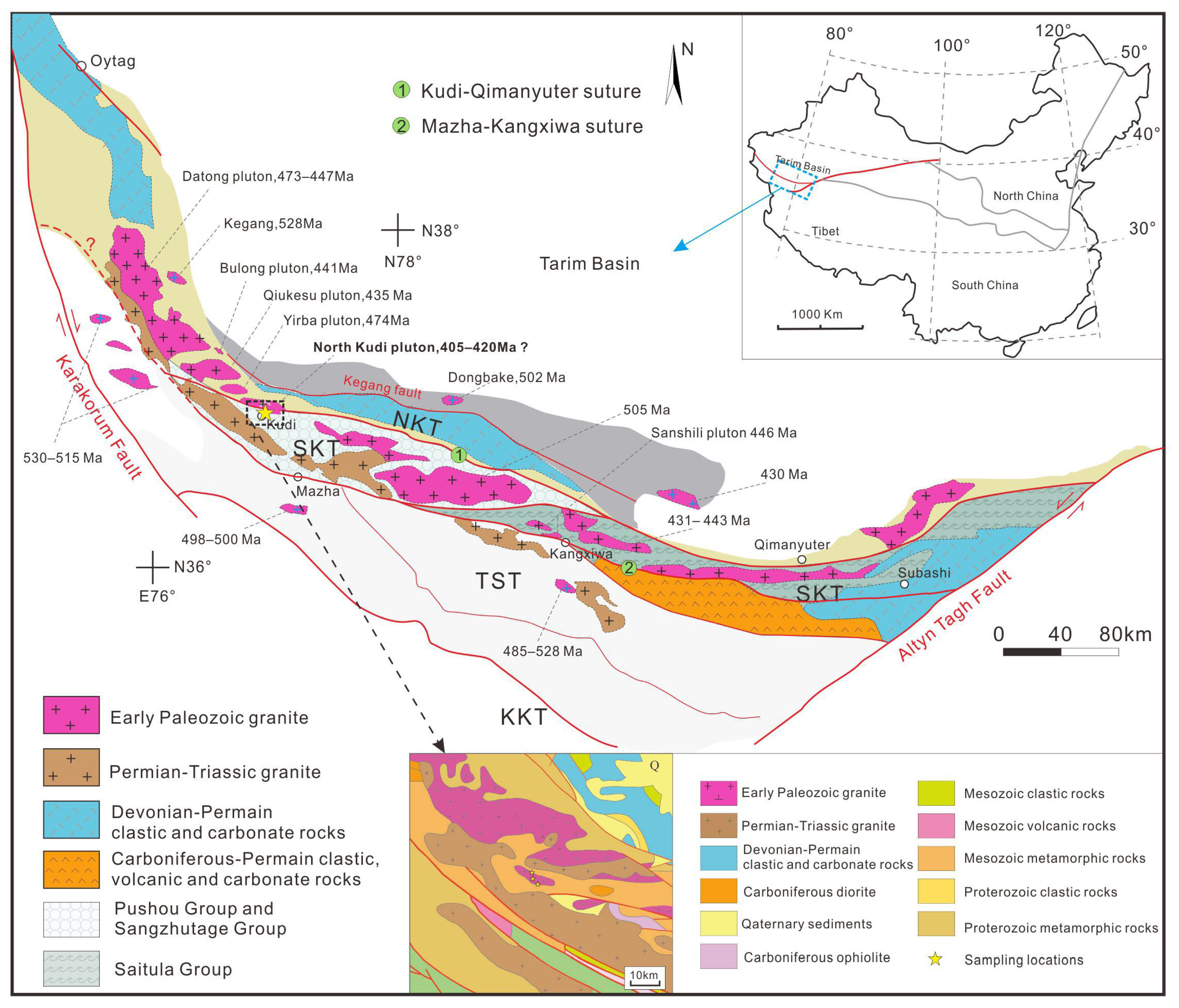
3. Analytical Methods
3.1. Zircon U–Pb Dating and Hf Isotopes
3.2. Whole-Rock Major and Trace Elements
3.3. Whole-Rock Sr–Nd Isotope
4. Results
4.1. Zircon U–Pb Ages and Hf Isotopic Compositions
4.2. Whole-Rock Geochemistry
4.3. Sr–Nd Isotopic Compositions
5. Discussion
5.1. Geochronology of the North Kudi Granitoids
5.2. Geochemical Features of A-Type Granite in the North Kudi Granites
5.3. Petrogenesis of the North Kudi Pluton
5.4. Geodynamic Implications
6. Conclusions
Supplementary Materials
Author Contributions
Funding
Data Availability Statement
Acknowledgments
Conflicts of Interest
References
- Bonin, B. A-type granites and related rocks: Evolution of a concept, problems and prospects. Lithos 2007, 97, 1–29. [Google Scholar] [CrossRef]
- Eby, G.N.; Woolley, A.R.; Ross, M. The A-type granitoids; a review of their occurrence and chemical characteristics and speculations on their petrogenesis. Lithos 1990, 26, 115–134. [Google Scholar] [CrossRef]
- Jiang, X.Y.; Ling, M.X.; Wu, K.; Zhang, Z.K.; Sun, W.D.; Sui, Q.L.; Xia, X.P. Insights into the origin of coexisting A1- and A2-type granites: Implications from zircon Hf-O isotopes of the Huayuangong intrusion in the Lower Yangtze River Belt, eastern China. Lithos 2018, 318–319, 230–243. [Google Scholar] [CrossRef]
- Loiselle, M.; Wones, D. Characteristics and origin of anorogenic granites, geological society of America abstracts with programs. Geol. Soc. Am. 1979, 11, 468. [Google Scholar]
- Collins, W.J.; Beams, S.D.; White, A.J.R.; Chappell, B.W. Nature and origin of A-type granites with particular reference to southeastern Australia. Contrib. Mineral. Petr. 1982, 80, 189–200. [Google Scholar] [CrossRef]
- Eby, G.N. Chemical subdivision of the A-type granitoids; petrogenetic and tectonic implications. Geology 1992, 20, 641–644. [Google Scholar] [CrossRef]
- Whalen, J.B.; Currie, K.L.; Chappell, B.W. A-type granites: Geochemical characteristics, discrimination and petrogenesis. Contrib. Mineral. Petr. 1987, 95, 407–419. [Google Scholar] [CrossRef]
- Jiang, X.; Zhang, Z.; Luo, J.; Wei, L.; Jiang, K. Two-stage, U-mineralization of A-type granites from the Huangmeijian complex, eastern China. Solid Earth Sci. 2023, 8, 12–24. [Google Scholar] [CrossRef]
- Ouyang, L.; Huang, W.; Wu, J.; Liao, J.; Zhang, J.; Chen, X.; Liang, H. Identification of the first Caledonian A-type granitoids in the southern Qin-Hang belt of south China: Tectonic link to early Paleozoic extension. Solid Earth Sci. 2023, 8, 68–85. [Google Scholar] [CrossRef]
- Zhang, Y.; Li, P.; Sun, M.; Yuan, C. Late Paleozoic to early Triassic granitoids from the Rudny Altai, Central Asian Orogenic Belt: Petrogenesis and implications for continental crustal evolution. Solid Earth Sci. 2020, 5, 115–129. [Google Scholar] [CrossRef]
- Zhao, Z.; Yang, X.; Zhang, Z.; Duan, Y. Petrogenesis and geodynamic implications of the Cretaceous anorogenic granitoids in east Qingling orogen. Solid Earth Sci. 2021, 6, 331–353. [Google Scholar] [CrossRef]
- King, P.L.; White, A.J.R.; Chappell, B.W.; Allen, C.M. Characterization and Origin of Aluminous A-type Granites from the Lachlan Fold Belt, Southeastern Australia. J. Petrol. 1997, 38, 371–391. [Google Scholar] [CrossRef]
- Jiang, X.Y.; Li, H.; Ding, X.; Wu, K.; Guo, J.; Liu, J.Q.; Sun, W.D. Formation of A-type granites in the Lower Yangtze River Belt: A perspective from apatite geochemistry. Lithos 2018, 304–307, 125–134. [Google Scholar] [CrossRef]
- Jiang, X.Y.; Luo, J.C.; Guo, J.; Wu, K.; Zhang, Z.K.; Sun, W.D.; Xia, X.P. Geochemistry of I- and A-type granites of the Qingyang-Jiuhuashan complex, eastern China: Insights into early cretaceous multistage magmatism. Lithos 2018, 316–317, 278–294. [Google Scholar] [CrossRef]
- Anderson, J.L.; Morrison, J. Ilmenite, magnetite, and peraluminous Mesoproterozoic anorogenic granites of Laurentia and Baltica. Lithos 2005, 80, 45–60. [Google Scholar] [CrossRef]
- Dall’Agnol, R.; de Oliveira, D.C. Oxidized, magnetite-series, rapakivi-type granites of Carajás, Brazil: Implications for classification and petrogenesis of A-type granites. Lithos 2007, 93, 215–233. [Google Scholar] [CrossRef]
- Patiño Douce, A.E. Generation of metaluminous A-type granites by low-pressure melting of calc-alkaline granitoids. Geology 1997, 25, 743–746. [Google Scholar] [CrossRef]
- Frost, C.D.; Frost, B.R. On ferroan (A-type) granitoids: Their compositional variability and modes of origin. J. Petrol. 2011, 52, 39–53. [Google Scholar] [CrossRef]
- Yang, J.H.; Wu, F.Y.; Chung, S.L.; Wilde, S.A.; Chu, M.F. A hybrid origin for the Qianshan A-type granite, northeast China: Geochemical and Sr–Nd–Hf isotopic evidence. Lithos 2006, 89, 89–106. [Google Scholar] [CrossRef]
- Wu, K.; Zhang, L.P.; Jiang, X.Y.; Zhang, Y.Q.; Sun, W.D.; Yuan, H.L. Geochemical Characteristics and SHRIMP Zircon U-Pb Age of the Putaishan Granite Porphyry and Their Geological Implications. Geotecton. Metallog. 2020, 44, 986–997. [Google Scholar]
- Chen, Y.X.; Cui, Y.; Song, S.G.; Wu, K.; Sun, W.D.; Xiao, T.F. Petrogenesis and tectonic implications of Cambrian Nb-enriched I-and aluminous A-type granites in the North Qilian suture zone. Int. Geol. Rev. 2021, 63, 1090–1109. [Google Scholar] [CrossRef]
- Guo, J.; Zheng, Y.F.; Zhao, Z.F.; Dai, L.Q. Generation of aluminous A-type granite by partial melting of felsic restite: Evidence from Mesozoic granitoids in the southern margin of the North China Craton. Lithos 2022, 428, 106837. [Google Scholar] [CrossRef]
- Gao, Y.J.; Niu, Y.L.; Duan, M.; Xue, Q.Q.; Sun, P.; Chen, S.; Xiao, Y.Y.; Guo, P.Y.; Wang, X.H.; Chen, Y.H. The petrogenesis and tectonic significance of the Early Cretaceous intraplate granites in eastern China: The Laoshan granite as an example. Lithos 2019, 328–329, 200–211. [Google Scholar] [CrossRef]
- Wu, F.Y.; Sun, D.Y.; Li, H.M.; Jahn, B.; Wilde, S. A-type granites in northeastern China; age and geochemical constraints on their petrogenesis. Chem. Geol. 2002, 187, 143–173. [Google Scholar] [CrossRef]
- Li, H.; Ling, M.X.; Ding, X.; Zhang, H.; Li, C.Y.; Liu, D.Y.; Sun, W.D. The geochemical characteristics of Haiyang A-type granite complex in Shandong, eastern China. Lithos 2014, 200, 142–156. [Google Scholar] [CrossRef]
- Liu, Z.; Jiang, Y.H.; Jia, R.Y.; Zhao, P.; Zhou, Q.; Wang, G.C.; Ni, C.Y. Origin of Middle Cambrian and Late Silurian potassic granitoids from the western Kunlun orogen, northwest China: A magmatic response to the Proto-Tethys evolution. Miner. Petrol. 2014, 108, 91–110. [Google Scholar] [CrossRef]
- Xiao, W.J.; Windley, B.; Liu, D.Y.; Jian, P.; Liu, C.Z.; Yuan, C.; Sun, M. Accretionary tectonics of the Western Kunlun Orogen, China: A Paleozoic–Early Mesozoic, long-lived active continental margin with implications for the growth of Southern Eurasia. J. Geol. 2005, 113, 687–705. [Google Scholar] [CrossRef]
- Mattern, F.; Schneider, W. Suturing of the Proto- and Paleo-Tethys oceans in the western Kunlun (Xinjiang, China). J. Asian Earth Sci. 2000, 18, 637–650. [Google Scholar] [CrossRef]
- Wang, J.; Hattori, K.; Liu, J.G.; Song, Y.; Gao, Y.B.; Zhang, H. Shoshonitic- and adakitic magmatism of the Early Paleozoic age in the Western Kunlun orogenic belt, NW China: Implications for the early evolution of the northwestern Tibetan plateau. Lithos 2017, 286–287, 345–362. [Google Scholar] [CrossRef]
- Xiao, W.J.; Han, F.L.; Windley, B.F.; Yuan, C.; Zhou, H.; Li, J.L. Multiple accretionary orogenesis and episodic growth of continents: Insights from the Western Kunlun Range, central Asia. Int. Geol. Rev. 2003, 45, 303–328. [Google Scholar] [CrossRef]
- Li, Y.C.; Xiao, W.J.; Tian, Z.H. Early Palaeozoic accretionary tectonics of West Kunlun Orogen: Insights from Datong granitoids, mafic-ultramafic complexes, and Silurian-Devonian sandstones, Xinjiang, NW China. Geol. J. 2018, 54, 1505–1517. [Google Scholar] [CrossRef]
- Yuan, C.; Sun, M.; Zhou, M.F.; Zhou, H.; Xiao, W.J.; Li, J.L. Absence of Archean basement in the South Kunlun Block: Nd-Sr-O isotopic evidence from granitoids. Isl. Arc 2003, 12, 13–21. [Google Scholar] [CrossRef]
- Wang, C.; Liu, L.; He, S.P.; Yang, W.Q.; Cao, Y.T.; Zhu, X.H.; Li, R.S. Early Paleozoic magmatism in west Kunlun: Constraints from geochemical and zircon U-Pb-Hf isotopic studies of the Bulong granite. Chin. J. Geol. 2013, 48, 997–1014. [Google Scholar]
- Zhu, J.; Li, Q.G.; Chen, X.; Tang, H.S.; Wang, Z.Q.; Chen, Y.J.; Liu, S.W.; Xiao, B.; Chen, J.L. Geochemistry and petrogenesis of the early Palaeozoic appinite-granite complex in the Western Kunlun Orogenic Belt, NW China: Implications for Palaeozoic tectonic evolution. Geol. Mag. 2018, 155, 1641–1666. [Google Scholar] [CrossRef]
- Li, T.F.; Zhang, J.X. Zircon LA-ICP-MS U-Pb ages of websterite and basalt in Kudi ophiolite and the implication, West Kunlun. Acta Petrol. Sin. 2014, 30, 2393–2401. [Google Scholar]
- Han, F.L.; Cui, J.T.; Ji, W.H.; Li, H.P.; Hao, J.W. Discovery of the Qimanyute ophiolite in the West Kunlun and its geological significance. Geol. Bull. China 2002, 21, 575–578. [Google Scholar]
- Cui, J.T.; Wang, J.C.; Bian, X.W.; Luo, Q.Z.; Zhu, H.P.; Wang, M.C.; Chen, G.C. Zircon SHRIMP U-Pb dating of the Dongbake gneissic tonalite in northern Kangxiwar, West Kunlun. Geol. Bull. China 2007, 26, 726–729. [Google Scholar]
- Cui, J.T.; Wang, J.C.; Bian, X.W.; Zhu, H.P. Geological characteristics of Early Paleozoic quartz diorite in the vicinity of Kangxiwar, West Kunlun, China and its zircon SHRIMP U-Pb dating. Geol. Bull. China 2006, 25, 1450–1457. [Google Scholar]
- Wang, J.C.; Cui, J.T.; Luo, Q.Z.; Bian, X.W.; Zhu, H.P.; Yang, K.J.; Peng, H.L.; Zhang, H.P.; Wang, F.; Lin, S.Y. The discovery and tectonic significance of a small branch ocean basin in monggubao-pushouyuan, Tethys ocean of northern Kangxiwa, west Kunlun mountains. Geol. Shaaxi 2006, 24, 41–50. [Google Scholar]
- Wu, K.; Zhang, L.P.; Jiang, X.Y.; Chen, Y.X.; Guo, J.; Sun, W.D.; Sui, Q.L.; Yuan, H.L. Continental crust growth during the evolution of accretionary orogens: Insights from the early Paleozoic granitoids in the Western Kunlun orogen, Northwest China. Lithos 2021, 398–399, 106253. [Google Scholar] [CrossRef]
- Li, B.Q.; Ji, W.H.; Bian, X.W.; Wang, F.; Li, W. The Composition and Geological Significance of the Mazha Tectonic Melange in West Kunlun Mountains. Geoscience 2007, 21, 78–86. [Google Scholar]
- Qu, J.F.; Zhang, L.F.; Ai, Y.L.; Lü, Z.; Wang, J.P.; Zhou, H.; Wang, S.Y. High-pressure granulite from Western Kunlun, northwestern China: Its metamorphic evolution, zircon SHRIMP U-Pb ages and tectonic implication. Sci. China Ser. D Earth Sci. 2007, 50, 429–441. [Google Scholar] [CrossRef]
- Yang, W.Q.; Liu, L.; Cao, Y.T.; Wang, C.; He, S.P.; Li, R.S.; Zhu, X.H. Geochronological evidence of Indosinian (high-pressure) metamorphic event and its tectonic significance in Taxkorgan area of the Western Kunlun Mountains, NW China. Sci. China Earth Sci. 2010, 53, 15. [Google Scholar] [CrossRef]
- Yuan, C.; Sun, M.; Zhou, M.F.; Zhou, H.; Xiao, W.J.; Li, J.L. Tectonic evolution of the West Kunlun: Geochronologic and geochemical constraints from Kudi Granitoids. Int. Geol. Rev. 2002, 44, 653–669. [Google Scholar] [CrossRef]
- Zhang, C.L.; Zou, H.B.; Ye, X.T.; Chen, X.Y. Tectonic evolution of the West Kunlun Orogenic Belt along the northern margin of the Tibetan Plateau: Implications for the assembly of the Tarim terrane to Gondwana. Geosci. Front. 2019, 10, 973–988. [Google Scholar] [CrossRef]
- Jiang, Y.H.; Yang, W.Z. High Contents of Th and U in Late Orogenic Granitoids to Track Lithospheric Delamination: Evidence from Granitoids in Western Kunlun Orogenic Belt, China. Chin. J. Geochem. 2000, 19, 267–272. [Google Scholar] [CrossRef]
- Zhu, J.; Liu, Q.G.; Wang, Z.Q.; Tang, H.S.; Chen, X.; Xiao, B. Magmatism and tectonic implications of early Cambrian granitoid plutons in Tianshuihai terrane of the Western Kunlun orogenic belt, Northwest China. Northwestern Geol. 2016, 49, 1–18. [Google Scholar]
- Hu, J.; Wang, H.; Mu, S.L.; Wang, M.; Hou, X.W. Geochemistry and Hf isotopic compositions of Early Paleozoic granites in Nanpingxueshan from the Tianshuihai Terrane, West Kunlun: Crust-Mantle magmatism. Acta Geol. Sin. 2017, 91, 16. [Google Scholar]
- Zhang, H.S.; He, S.P.; Ji, W.H.; Wang, C.; Shi, J.B.; Kang, K.Y.; Zhang, J.; Zhu, D.W.; Tang, H.W.; Li, C.D.; et al. Implications of Late Cambrian granite in Tianshuihai Massif for the evolution of Proto-Tethys Ocean: Evidences from zircon geochronology and geochemistry. Acta Geol. Sin. 2016, 90, 21. [Google Scholar]
- Wu, K.; Ling, M.X.; Hu, Y.B.; Guo, J.; Jiang, X.Y.; Sun, S.J.; Liang, H.Y.; Liu, X.; Sun, W.D. Melt-Fluxed Melting of the Heterogeneously Mixed Lower Arc Crust: A Case Study from the Qinling Orogenic Belt, Central China. Geochem. Geophys. Geosyst. 2018, 19, 1767–1788. [Google Scholar] [CrossRef]
- Li, X.H.; Tang, G.Q.; Gong, B.; Yang, Y.H.; Hou, K.J.; Hu, Z.C.; Li, Q.L.; Liu, Y.; Li, W.X. Qinghu zircon: A working reference for microbeam analysis of U-Pb age and Hf and O isotopes. Chin. Sci. Bull. 2013, 58, 8. [Google Scholar] [CrossRef]
- Liu, Y.S.; Hu, Z.C.; Gao, S.; Günther, D.; Xu, J.; Gao, C.G.; Chen, H.H. In situ analysis of major and trace elements of anhydrous minerals by LA-ICP-MS without applying an internal standard. Chem. Geol. 2008, 257, 34–43. [Google Scholar] [CrossRef]
- Zhang, L.; Ren, Z.Y.; Xia, X.P.; Li, J.; Zhang, Z.F. IsotopeMaker: A Matlab program for isotopic data reduction. Int. J. Mass Spectrom. 2015, 392, 118–124. [Google Scholar] [CrossRef]
- Bouvier, A.; Vervoort, J.D.; Patchett, P.J. The Lu-Hf and Sm-Nd isotopic composition of CHUR: Constraints from unequilibrated chondrites and implications for the bulk composition of terrestrial planets. Earth Planet. Sc. Lett. 2008, 273, 48–57. [Google Scholar] [CrossRef]
- Wei, G.J. Precise measurement of Sr isotopic composition of liquid and solid base using (LP) MC-ICPMS. Geochimica 2002, 31, 295–299. [Google Scholar]
- Streckeisen, A.; Le Maitre, R. A chemical approximation to the modal QAPF classification of the igneous rocks. Neues Jahrb. Mineral. Abh. 1979, 136, 169–206. [Google Scholar]
- Sun, S.S.; McDonough, W.F. Chemical and isotopic systematics of oceanic basalts: Implications for mantle composition and processes. Geol. Soc. Lond. Spec. Publ. 1989, 42, 313–345. [Google Scholar] [CrossRef]
- Jia, R.Y.; Jiang, Y.H.; Liu, Z.; Zhao, P.; Zhou, Q. Petrogenesis and tectonic implications of early Silurian high-K calc-alkaline granites and their potassic microgranular enclaves, western Kunlun orogen, NW Tibetan Plateau. Int. Geol. Rev. 2013, 55, 958–975. [Google Scholar] [CrossRef]
- Corfu, F.; Hanchar, J.M.; Hoskin, P.W.; Kinny, P. Atlas of zircon textures. Rev. Mineral. Geochem. 2003, 53, 469–500. [Google Scholar] [CrossRef]
- Mattern, F.; Schneider, W.; Li, Y.A.; Li, X.D. A traverse through the western Kunlun (Xinjiang, China): Tentative geodynamic implications for the Paleozoic and Mesozoic. Geol. Rundsch. 1996, 85, 705–722. [Google Scholar] [CrossRef]
- Zhou, H.; Li, J.L. Age and geochemical features of lamprophyres in Kuda, western Kunlun. Acta Petrol. Sin. 2000, 16, 380–384. [Google Scholar]
- Chen, Y.X.; Li, H.; Sun, W.D.; Ireland, T.; Tian, X.F.; Hu, Y.B.; Yang, W.B.; Chen, C.; Xu, D.R. Generation of Late Mesozoic Qianlishan A2-type granite in Nanling Range, South China: Implications for Shizhuyuan W-Sn mineralization and tectonic evolution. Lithos 2016, 266–267, 435–452. [Google Scholar] [CrossRef]
- Pearce, J.A.; Harris, N.B.; Tindle, A.G. Trace element discrimination diagrams for the tectonic interpretation of granitic rocks. J. Petrol. 1984, 25, 956–983. [Google Scholar] [CrossRef]
- Watson, E.B.; Harrison, T.M. Zircon saturation revisited: Temperature and composition effects in a variety of crustal magma types. Earth Planet. Sc. Lett. 1983, 64, 295–304. [Google Scholar] [CrossRef]
- Dall’Agnol, R.; Scaillet, B.; Pichavant, M. An experimental study of a lower Proterozoic A-type granite from the Eastern Amazonian Craton, Brazil. J. Petrol. 1999, 40, 1673–1698. [Google Scholar] [CrossRef]
- Chen, Y.X.; Cui, Y.; Zhang, L.P.; Fu, S.M.; Wu, K.; Song, S.G.; Sun, W.D.; Xiao, T.F. Sediment recycling and adakite petrogenesis: Constraints from the late Ordovician tonalite in the North Qilian suture zone. Chem. Geol. 2023, 624, 121389. [Google Scholar] [CrossRef]
- Bogaerts, M.; Scaillet, B.; Auwera, J.V. Phase equilibria of the Lyngdal granodiorite (Norway): Implications for the origin of metaluminous ferroan granitoids. J. Petrol. 2006, 47, 2405–2431. [Google Scholar] [CrossRef]
- Skjerlie, K.P.; Patiño Douce, A.E.; Johnston, A.D. Fluid absent melting of a layered crustal protolith: Implications for the generation of anatectic granites. Contrib. Mineral. Petr. 1993, 114, 365–378. [Google Scholar] [CrossRef]
- Skjerlie, K.P.; Johnston, A.D. Fluid-absent melting behavior of an F-rich tonalitic gneiss at mid-crustal pressures: Implications for the generation of anorogenic granites. J. Petrol. 1993, 34, 785–815. [Google Scholar] [CrossRef]
- Clemens, J.D.; Holloway, J.R.; White, A.J.R. Origin of an A-type granite; experimental constraints. Am. Mineral. 1986, 71, 317–324. [Google Scholar]
- Qian, L.; Wang, Y.; Xie, J.; Sun, W. The Late Mesozoic granodiorite and polymetallic mineralization in southern Anhui Province, China: A perspective from apatite geochemistry. Solid Earth Sci. 2019, 4, 178–189. [Google Scholar] [CrossRef]
- Wu, K.; Yuan, H.L.; Lyn, N.; Zhang, L.P. The behavior of fluid mobile elements during serpentinization and dehydration of serpentinites in subduction zones. Acta Petrol. Sin. 2020, 36, 141–153. [Google Scholar]
- Wu, K.; Ding, X.; Ling, M.X.; Sun, W.D.; Zhang, L.P.; Hu, Y.B.; Huang, R.F. Origins of two types of serpentinites from the Qinling orogenic belt, central China and associated fluid/melt-rock interactions. Lithos 2018, 302–303, 50–64. [Google Scholar] [CrossRef]
- Wu, K.; Zhang, L.P.; Yuan, H.L.; Sun, W.D.; Deng, J.H.; Zartman, R.E.; Guo, J.; Bao, Z.A.; Zong, C.L. Boron, arsenic and antimony recycling in subduction zones: New insights from interactions between forearc serpentinites and CO2-rich fluids at the slab-mantle interface. Geochim. Cosmochim. Acta 2021, 298, 21–42. [Google Scholar] [CrossRef]
- Zhang, L.P.; Deng, J.H.; Sun, S.J.; Sui, Q.L.; Wang, K.; Sun, W.D. Subduction of the Neo-Tethys ridge beneath the Eurasian continent during the Cretaceous. Ore Geol. Rev. 2023, 154, 105302. [Google Scholar] [CrossRef]
- Zhang, L.P.; Cao, Z.B.; Zartman, R.E.; Li, C.Y.; Sun, S.J.; Liu, L.J.; Sun, W.D. An emerging plume head interacting with the Hawaiian plume tail. Innovation 2023, 4, 100404. [Google Scholar] [CrossRef]
- Wu, K.; Ling, M.X.; Sun, W.D.; Guo, J.; Zhang, C.C. Major transition of continental basalts in the Early Cretaceous: Implications for the destruction of the North China Craton. Chem. Geol. 2017, 470, 93–106. [Google Scholar] [CrossRef]
- Wang, Z.H. Tectonic evolution of the western Kunlun orogenic belt, western China. J. Asian Earth Sci. 2004, 24, 153–161. [Google Scholar]
- Huang, J.G.; Cui, C.L.; Yang, J.; Zhu, Y.Y. Geochemical characteristics and tectonic significance of the Silurian granite rocks in the Taer region of the Western Kunlun. Geochimica 2017, 46, 11. [Google Scholar]
- Zhang, Q.C.; Liu, Y.; Huang, H.; Wu, Z.H.; Zhou, Q. Petrogenesis and tectonic implications of the high-K Alamas calc-alkaline granitoids at the northwestern margin of the Tibetan Plateau: Geochemical and Sr–Nd–Hf–O isotope constraints. J. Asian Earth Sci. 2016, 127, 137–151. [Google Scholar] [CrossRef]
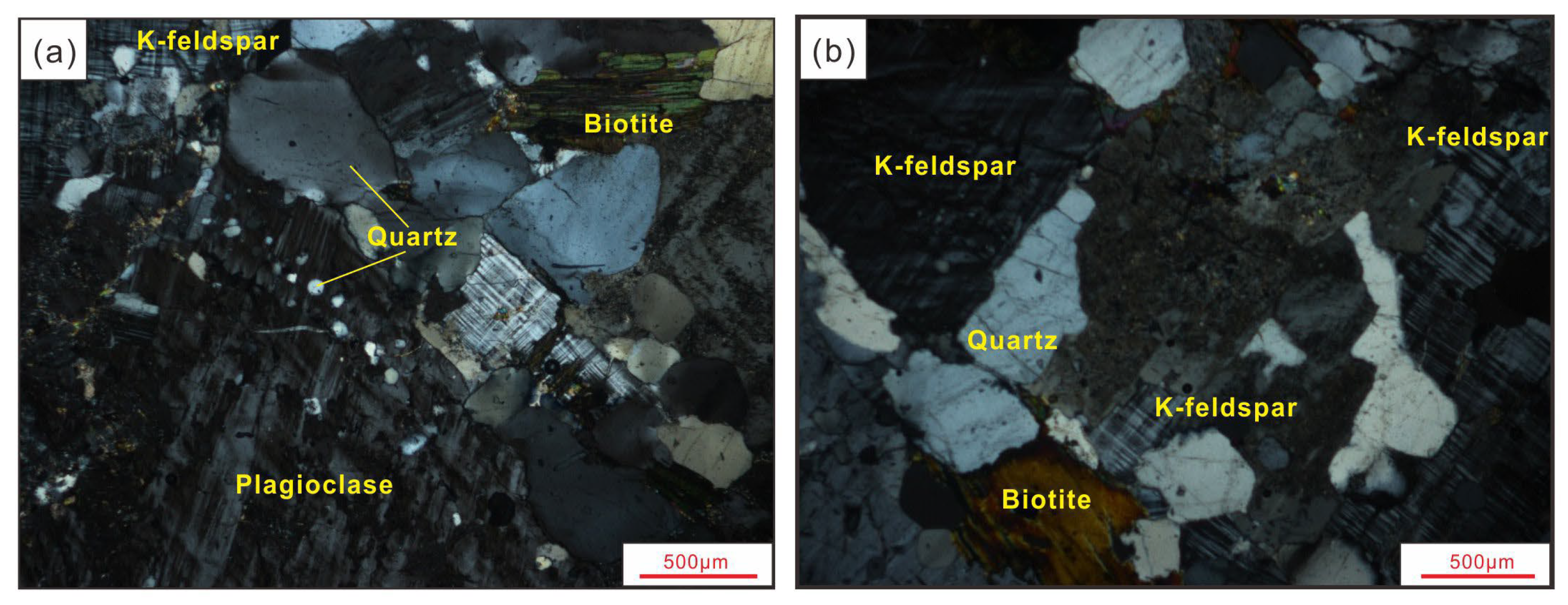

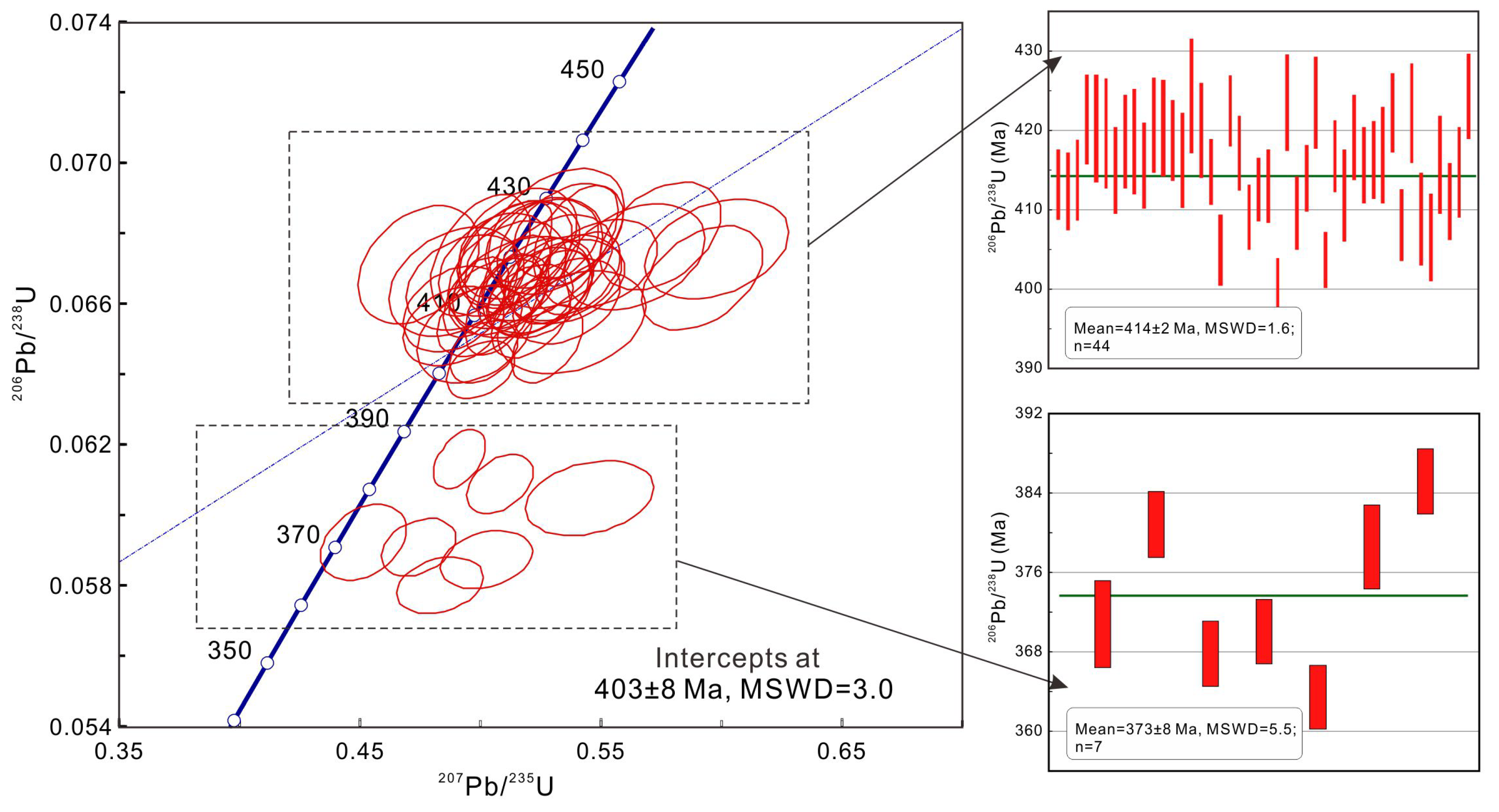
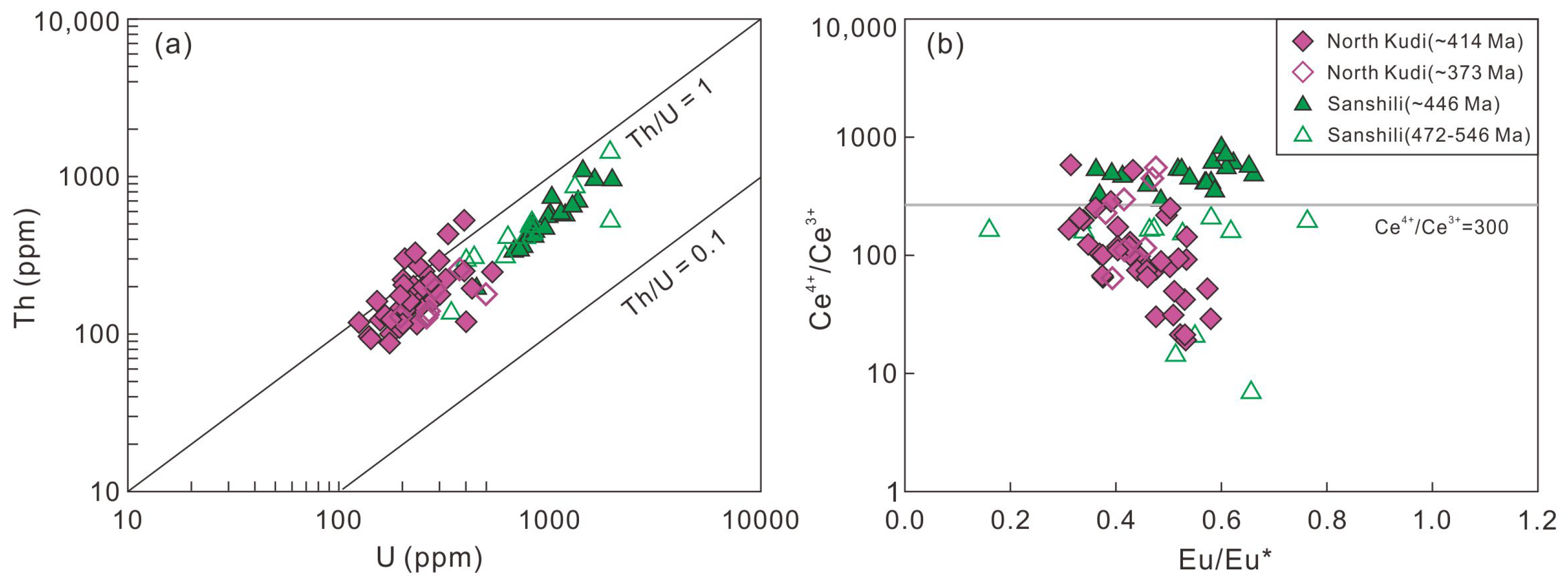
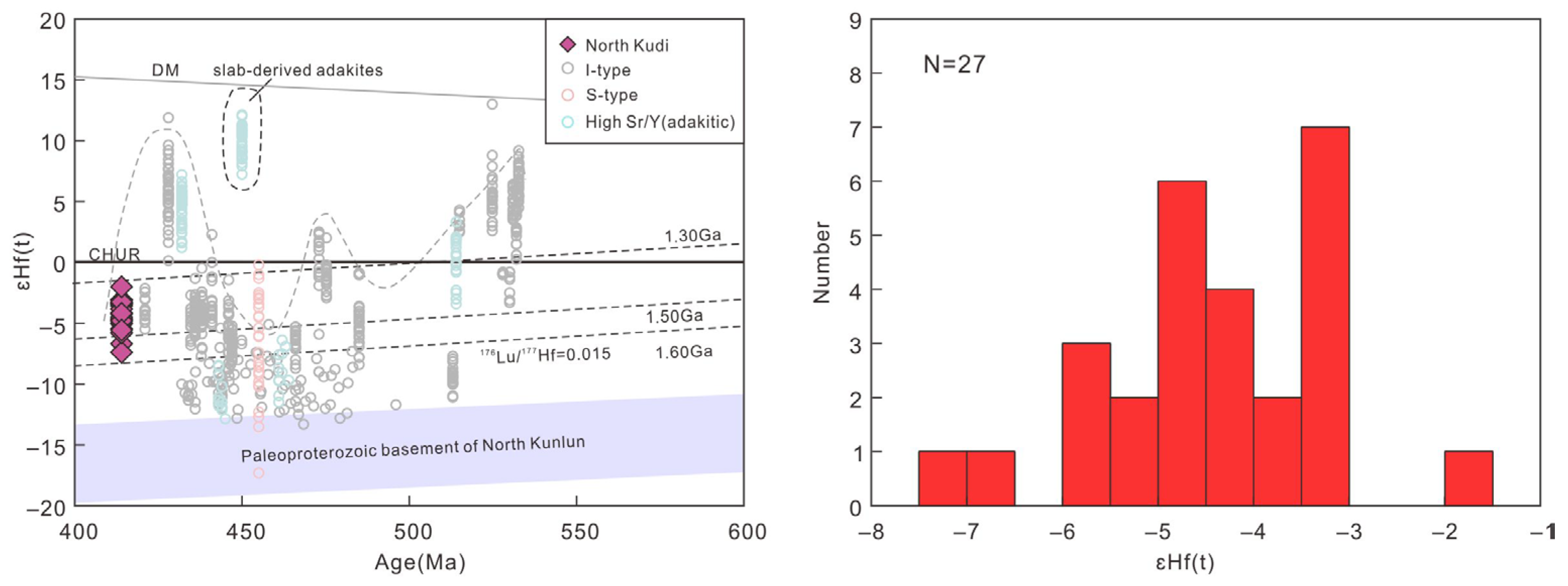
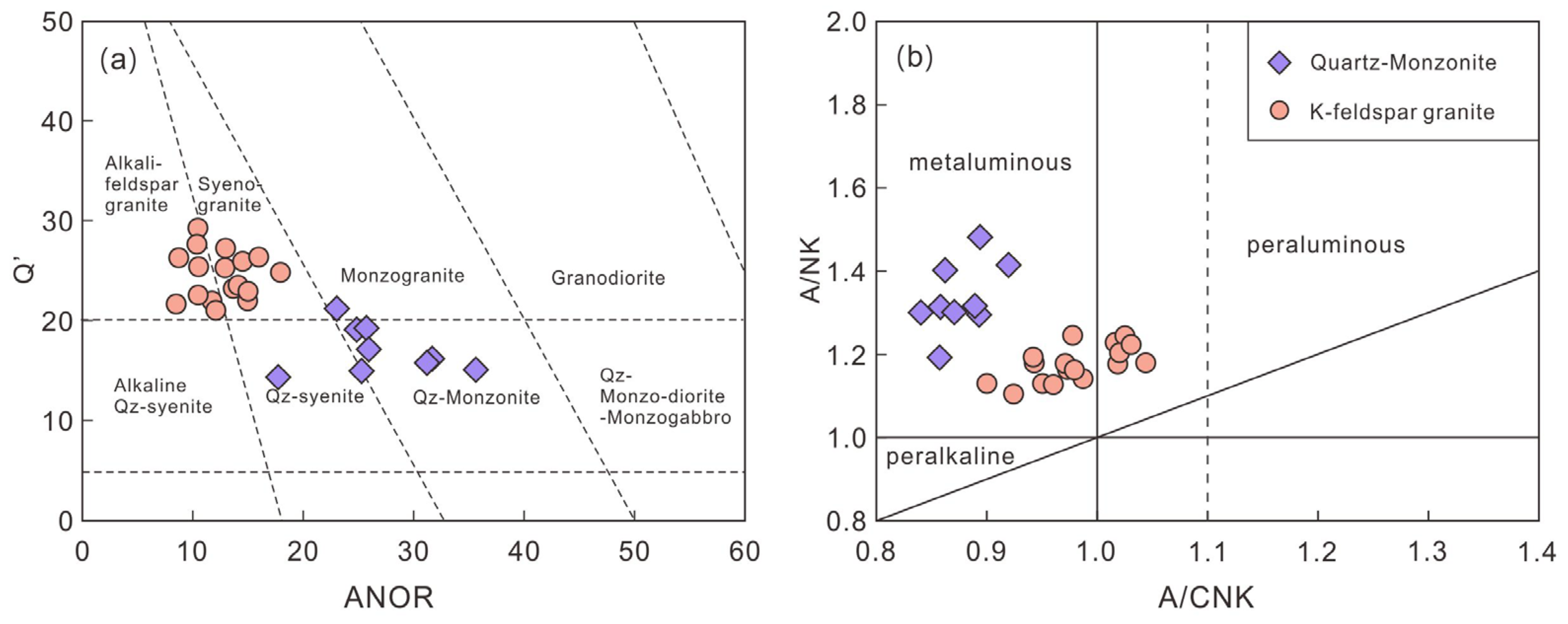



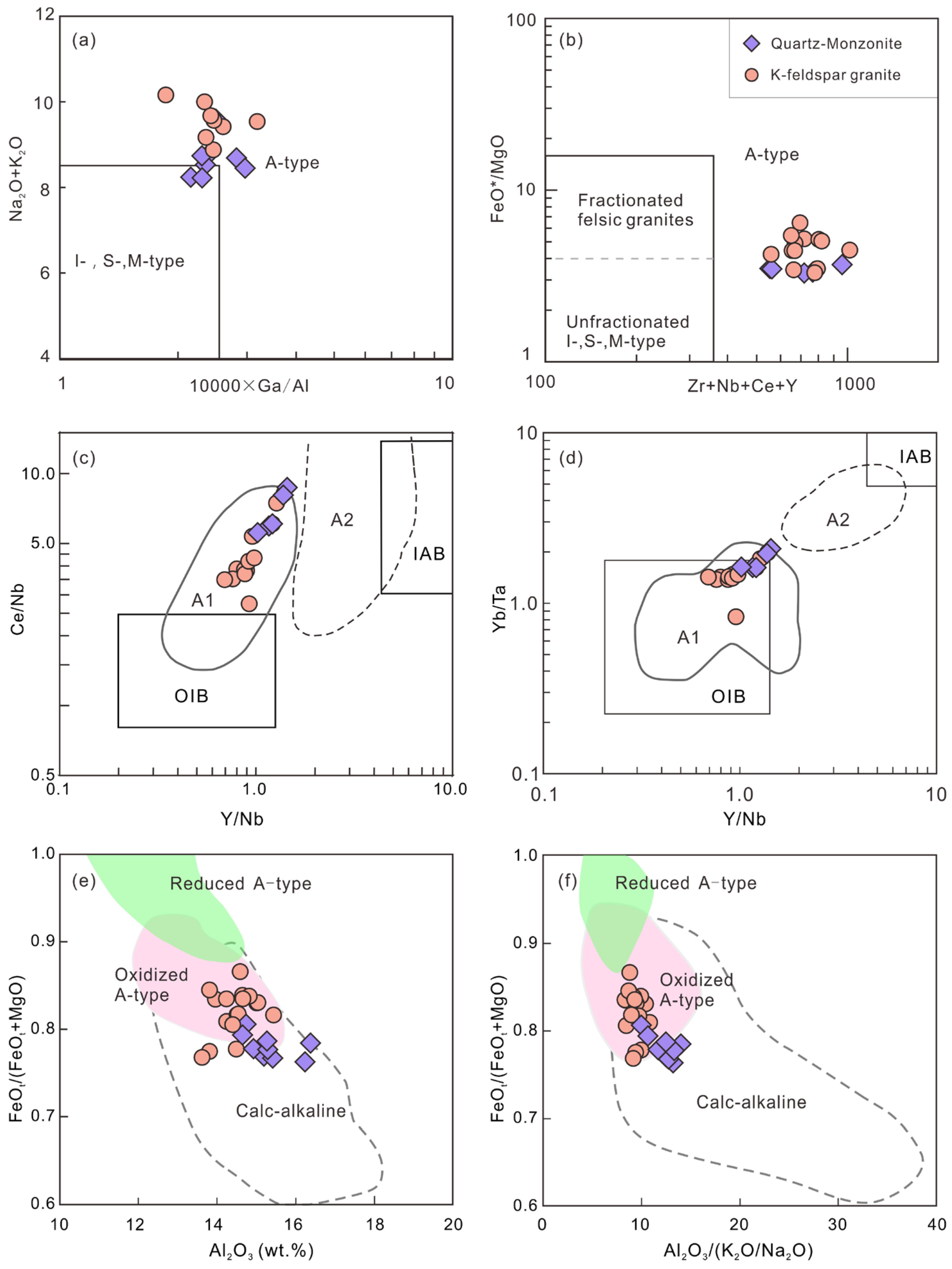
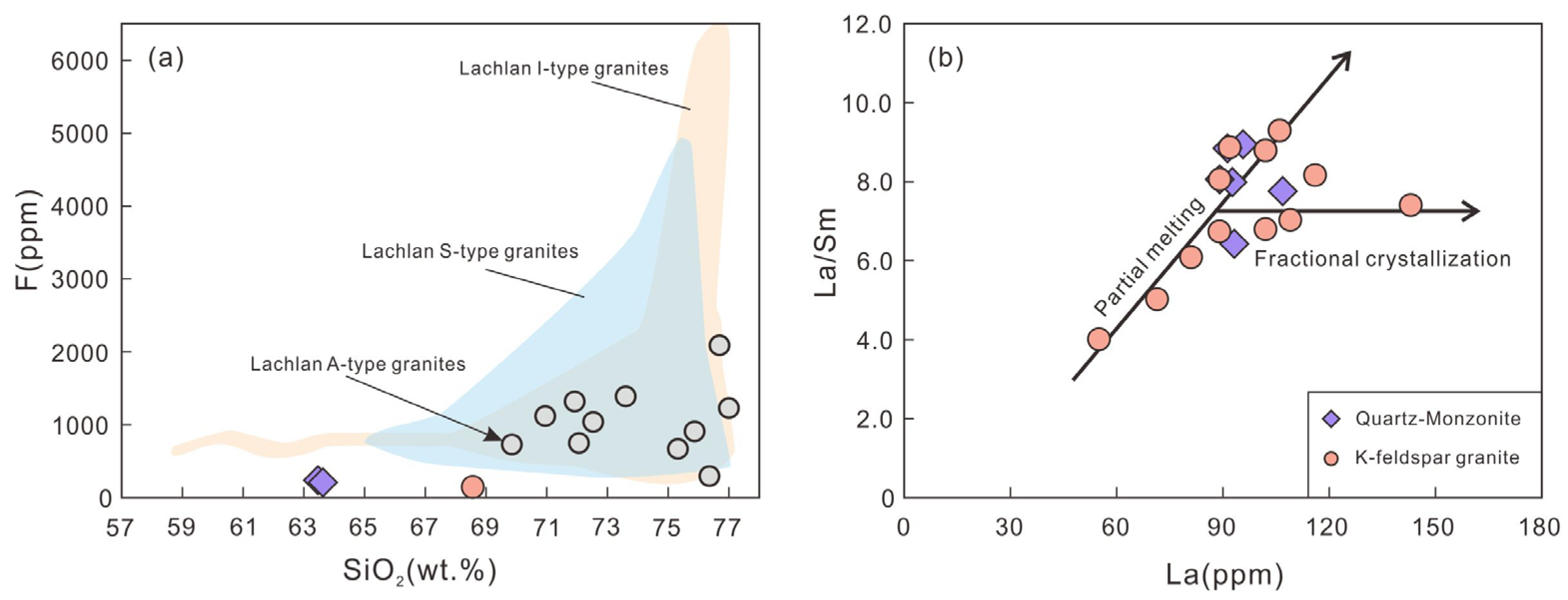
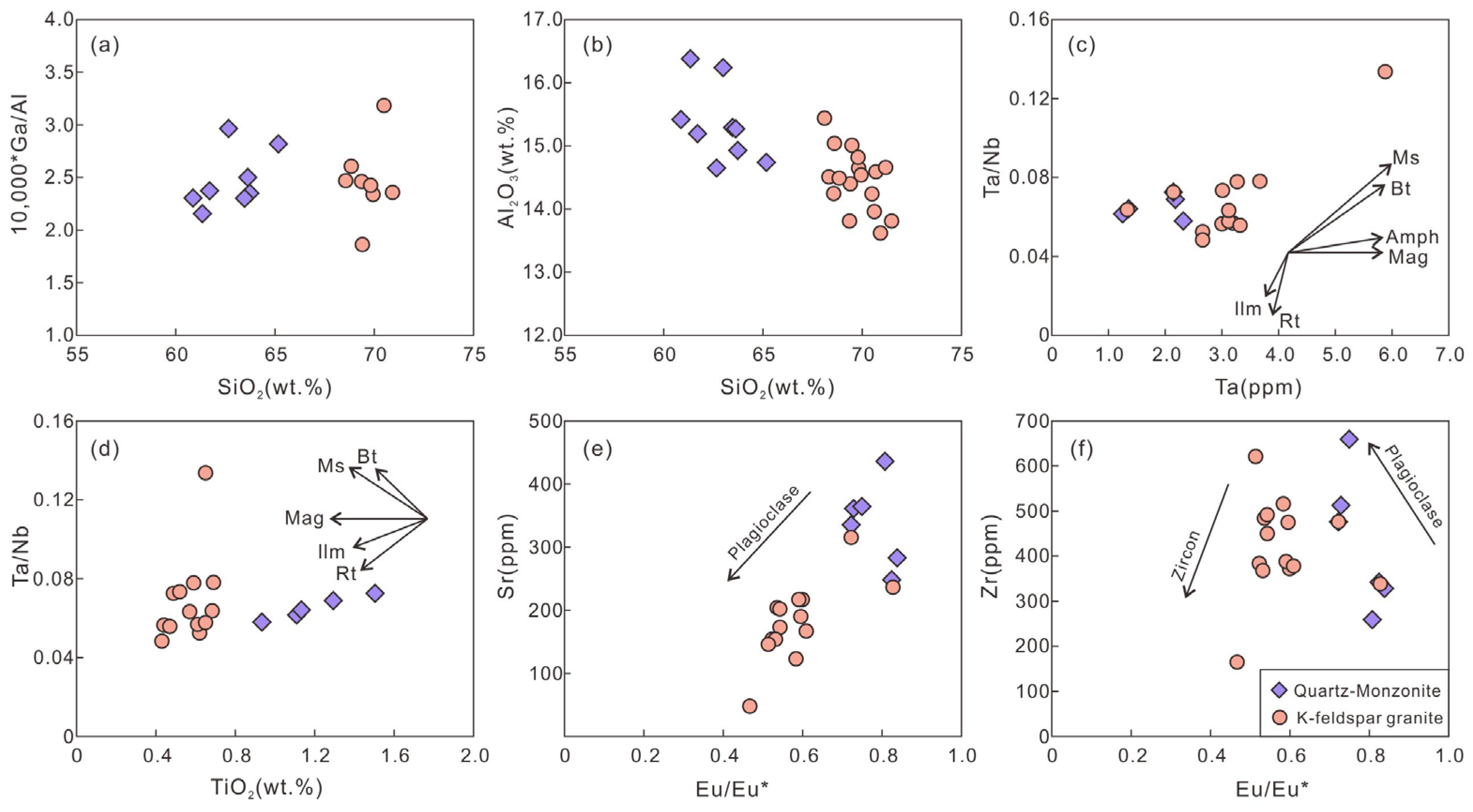
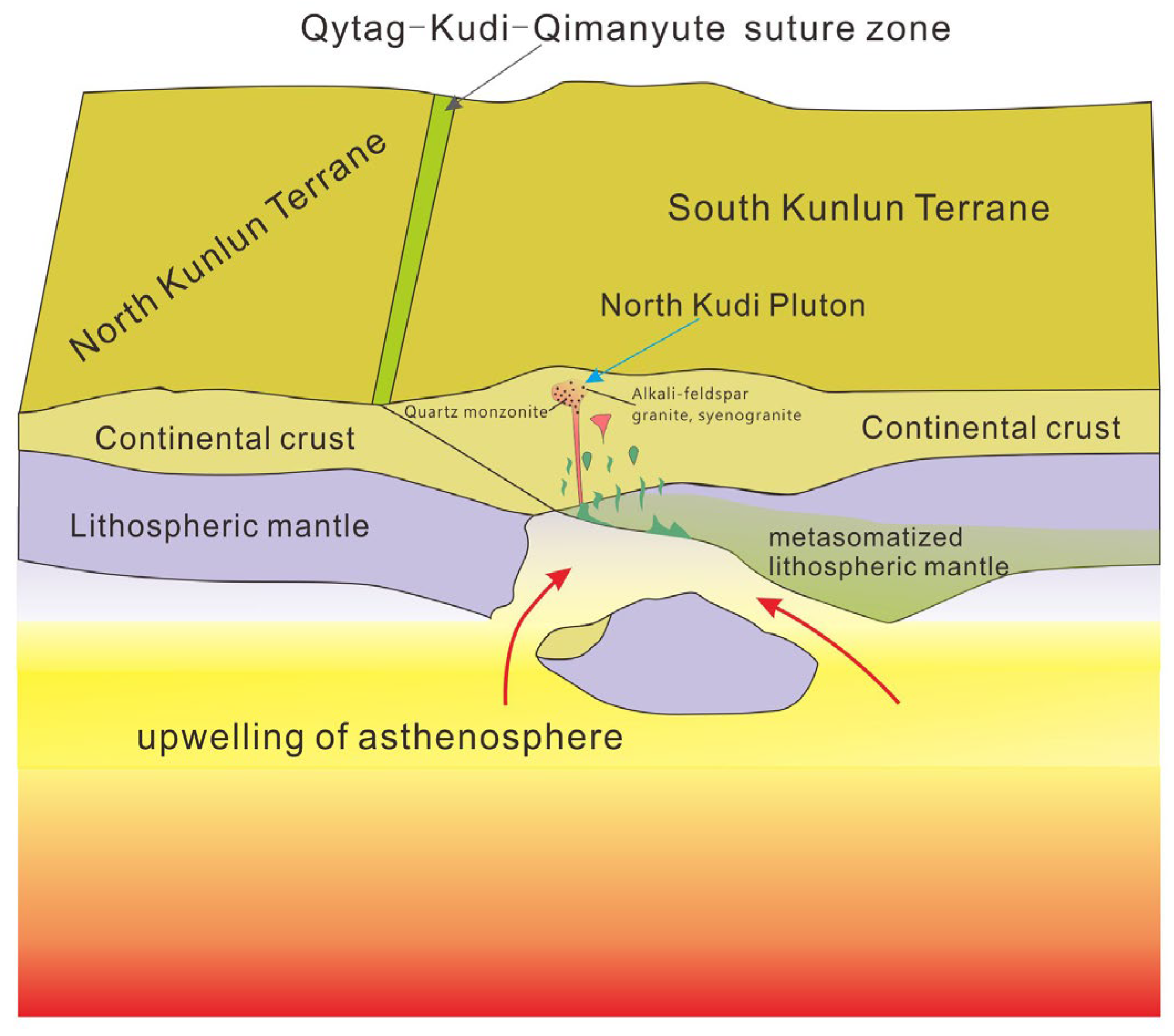
Disclaimer/Publisher’s Note: The statements, opinions and data contained in all publications are solely those of the individual author(s) and contributor(s) and not of MDPI and/or the editor(s). MDPI and/or the editor(s) disclaim responsibility for any injury to people or property resulting from any ideas, methods, instructions or products referred to in the content. |
© 2023 by the authors. Licensee MDPI, Basel, Switzerland. This article is an open access article distributed under the terms and conditions of the Creative Commons Attribution (CC BY) license (https://creativecommons.org/licenses/by/4.0/).
Share and Cite
Wu, K.; Gong, M.; Jiang, X.; Ling, M.; Yuan, H. Petrogenesis and Geodynamic Implications of the North Kudi Granitoids in the West Kunlun Orogen, NW China. Minerals 2023, 13, 941. https://doi.org/10.3390/min13070941
Wu K, Gong M, Jiang X, Ling M, Yuan H. Petrogenesis and Geodynamic Implications of the North Kudi Granitoids in the West Kunlun Orogen, NW China. Minerals. 2023; 13(7):941. https://doi.org/10.3390/min13070941
Chicago/Turabian StyleWu, Kai, Meijun Gong, Xiaoyan Jiang, Mingxing Ling, and Honglin Yuan. 2023. "Petrogenesis and Geodynamic Implications of the North Kudi Granitoids in the West Kunlun Orogen, NW China" Minerals 13, no. 7: 941. https://doi.org/10.3390/min13070941
APA StyleWu, K., Gong, M., Jiang, X., Ling, M., & Yuan, H. (2023). Petrogenesis and Geodynamic Implications of the North Kudi Granitoids in the West Kunlun Orogen, NW China. Minerals, 13(7), 941. https://doi.org/10.3390/min13070941





